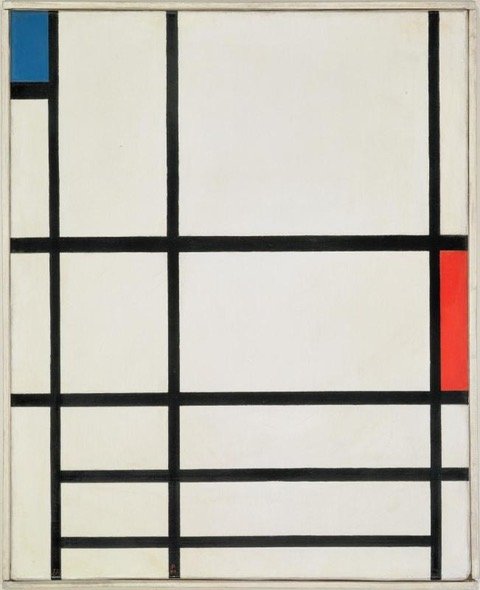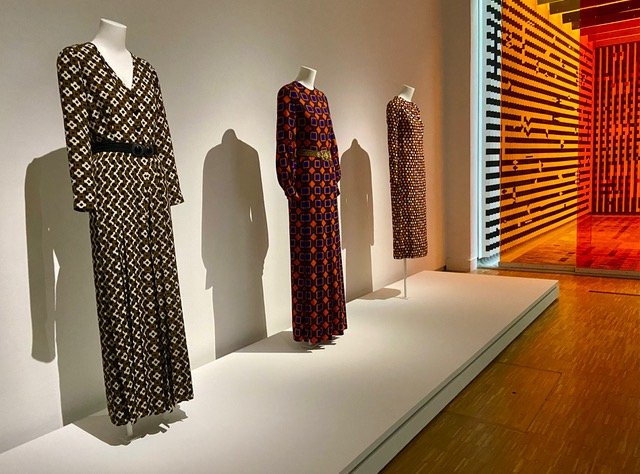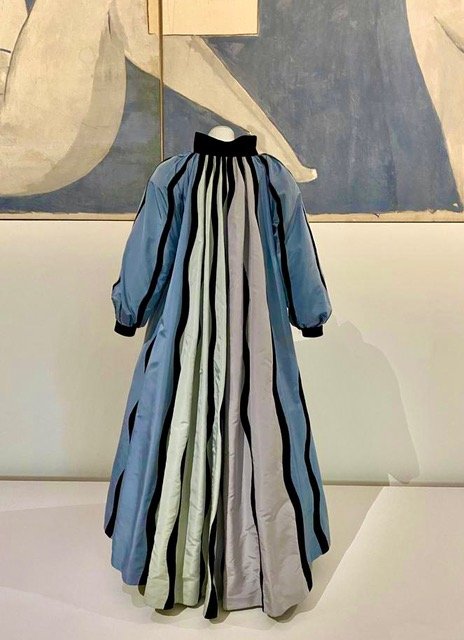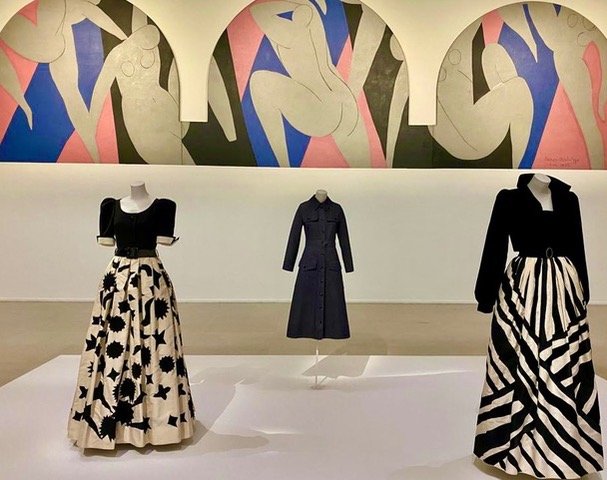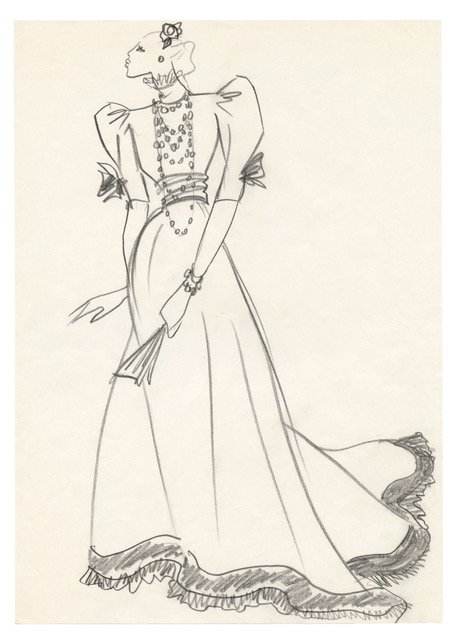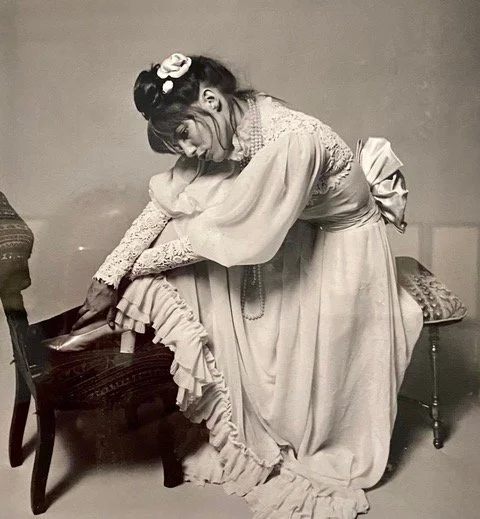Mondrians and Madeleines, part deux
Yves Saint Laurent Aux Musées
Yves Saint Laurent by Andy Warhol, 1972
Now that we all know a little bit more about the demands of Haute Couture and a little more about the hero of this tale, Yves Saint Laurent, let’s go museum hopping.
The exhibitions that are scattered throughout Paris are not unique because clothes are displayed in museums. Fashion exhibitions have been held in museums for a while now. But like any other temporary exhibition, they are held in spaces dedicated to temporary exhibitions. What is new and different about these exhibitions is that Yves Saint Laurent’s creations are intermingled with each museum’s permanent collection, alongside the paintings and sculptures that inspired them. (Figure 1)
Figure 1. Painting by Picasso, Gown by Saint Laurent, photo of Saint Laurent thinking
As one critic noted, Saint Laurent never intended to make wearable reproductions of the art he admired. He said, “I have not copied them—who would venture to do so?”. His works he said were Homages. To him it was obvious “that composition and construction were fundamental practices shared by art and fashion”.
That doesn’t really answer the question ‘Is fashion art’. The co-curator of this exhibition thinks that by now, we should be past asking that question. And of course, it is not only fashion that prompts the question. “But is it art?” Some people didn’t / don’t consider Christo’s Wrapping art, either. Or Duchamp’s Readymades. Or Banksy’s stencils. Definitions of art expand over time and become more inclusive.
The pleasures of this exhibition were at least threefold. Seeing examples of beautiful haute couture up close. Seeing them juxtaposed with the art that inspired them. And wandering through a museum’s permanent collection with purpose.
My first stop on this six museum odyssey was the Pompidou where thirteen Saint Laurent displays are scattered through the museum’s permanent collection. The fun of discovery was ever present. A scavenger hunt without any clues.
Permanent collections in big museums depress me. Watching people trudge along corridor after corridor, past painting after painting, depresses me. And the Pompidou is a difficult space to navigate. Perhaps it is harder for me than for you because I have no sense of direction. My husband used to tell me to go in the opposite direction from the one I thought I should go in. That works about 50% of the time.
Saint Laurent’s costumes, mostly gowns, are on the 5th (modern art to 1960s) and 4th (1960s to present) floors. Seeing those paintings and sculptures was like seeing old friends. Excellent wall text (in French & English) introduce themes and movements and explain specific art works.
The artist we most immediately connect with Yves Saint Laurent is the Dutch Modernist, Piet Mondrian. According to the designer, “It wasn’t until I opened a Mondrian book my mother had given me for Christmas that I hit on the key idea.” As the curator of this exhibition noted, “Only art historians knew Mondrian when Saint Laurent decided to dedicate his 1965 fall-winter line to him”.
Wow. Saint Laurent introduced Mondrian to the general public. Four years later, the Pompidou mounted its first Mondrian retrospective. And it wasn’t until 1975 that, “Composition in Red, Blue and White II,” (Figure 2) entered the museum’s permanent collection. At the Pompidou, a Saint Laurent Mondrian dress and this Mondrian painting stand side by side. (Figures 3, 4)
Figure 2. Composition in Red, Blue and White II,, Piet Mondrian, 1930
Figure 3. Left Homage à Mondrian, Saint Laurent, 1966. Right, Not the inspiration, but the Pompidou’s first Mondrian
Figure 4. Saint Laurent, Homage à Mondrian, 1965
The Mondrian inspired dresses (only 6 dresses out of an 80 piece collection) are all A-line cocktail dresses. The design is not printed on the dresses. Each of the colored blocks and black bands are individual pieces sewn together. At the Fondation YSL, in a video interview with one of the seamstresses who had worked with Saint Laurent for a very long time, she said that of all the dresses she worked on for YSL, this simple dress was the most difficult. Because it was the most exacting. It had to be perfect. The darts and seams had to be invisible. The painting was the starting point of a dress that was tailored to flatter the female form.
Thirty years earlier, Elsa Schiaparelli channeled Salvador Dalí when she put a lobster on an evening gown and a Dali designed upside down shoe on a model’s head (Figures 5, 6). But I think we can agree that Saint Laurent goes beyond that.
Figure 5. Elsa Schaperelli, Lobster Gown, 1937
Figure 6. Salvador Dali, Shoe Hat for Elsa Schaperelli, 1937
Saint Laurent paid tribute to art again the following year. This time the inspiration was Pop Art. Saint Laurent said, ”How could I have resisted Pop Art, which was the expression of my youth”. The dresses are of jersey, which Saint Laurent considered the "only modern material”. The collection includes some seriously playful dresses inspired by the American pop artist Tom Wesselmann’s "Great American Nudes" series. (Figure 7) There is no exact correlation. Instead, Saint Laurent found and extracted elements from the paintings that best suited his own art form and what he was after.. The 2009 painting, in the spirit of Wesselmann, by the contemporary English artist Gary Hume is paired here with one of Saint Laurent’s gowns from the series. (Figures 8. 9)
Figure 7. Left, Tom Wesselmann paintings; Right Saint Laurent, Tribute to Tom Wesselmann, Great American Nude Series,, 1966
Figure 8. The Moon, Gary Hume, 2009
Figure 9. Left, Gary Hume, The Moon, 2009, Right, Saint Laurent, Homage à Wesselmann, 1966
Yves Saint Laurent collection from 1971 channeled the Nazi Occupation of France. Which I guess you could say was a curious choice. It came to be known as the Scandal Collection, because it offended everyone. But he didn’t forget Art. One piece was inspired by a painting by the French artist, Martial Raysse, a contemporary of Saint Laurent. It’s called Made in Japan-La Grande Odalisque. (Figure 10) It references Ingres’ Grande Odalisque. (Figure 11) But Raysse has cut her off at the shoulders, painted her green, omitted an eye and added a fly above her head. She’s no longer an elegant beauty. The artist has appropriated an iconic painting from the past, not to honor it but to mock it. And ‘Made in Japan’ was not a compliment at the time.
Figure 10. Made in Japan-La Grande Odalisque, Martial Raysse, 1971
Figure 11. La Grande Oldalisque, Ingres, 1814
Saint Laurent designed neon green fox coat. (Figures 12, 13) More or less the same green as Raysse’s riff on Ingres. As a curator at the Pompidou explains, “It takes up the codes of fashion under occupation: short coat, broad shoulders, furs”. The critics thought the entire collection was an exercise in bad taste, and yet the collection (not just this jacket) has been credited with launching the ‘retro’ style in fashion.
Figure 12. Fox coat, Saint Laurent, 1971
Figure 13. Left, Martial Raysse, Right, Saint Laurent, 1971
Let’s look at one more example. A painting by Henri Matisse called La Blouse Roumaine, painted in 1940. (Figure 14) The artist made the decorative embroidery of the blouse the real subject of the painting. By simplifying the pattern and accentuating the sleeves, the blouse has become an abstract design in and of itself.
Figure 14. La Blouse Roumaine, Henri Matisse, 1940
For Saint Laurent, Matisse’s painting was the bridge for the transformation of an ethnic blouse figure 15) into an elegant and refined top. He is credited with being the first haute couture designer to do this. (Figures 16, 17) Called “She,” it was the star of Saint Laurent’s 1981 collection, a tribute to Henri Matisse.
Figure 15. Ukrainian Chorus Dumka of New York on Saturday Night Live, February 2022
Figure 16. ‘She’ Homage à Henri Matisse, Yves Saint Laurent, 1981
Figure 17. Left La Roumaine, Matisse; Right ‘She’ Homage à Matisse, Saint Laurent
Okay, before we leave the Pompidou, here’s a shout out to Fernand Leger’s 1952 pop art flower sculpture Polychrome Flower, Saint Laurent’s 1981 evening dress “Homage to Fernand Léger”. (Figures 18) And one to Victor Vasarely’s Op Art (Figure 19).
Figure 18. Left, Ferdnand Leger ‘Polychrome Flower,’ 1952; Right Saint Laurent, ‘Homage to Léger’ 1981
Figure 19. Homage à Victor Vasarely
Yes, I am dragging myself and you away from the Pompidou to the Picasso which is just a few blocks away. The exhibition isn’t mentioned on the museum’s website. Because, I was told, it is only in one room. But what a jewel of a room it is. When asked what painter he felt closest to, Saint Laurent answered “Picasso, always.”
Let’s just look at one painting and one jacket from the 1979 Autumn-Winter collection. The painting is Picasso’s portrait of Nusch Éluard, wearing an Elsa Schiaparelli jacket. (Figure 20) Saint Laurent’s jacket is directly inspired by the one worn by the sitter. (Figure 21) So, from fashion to painting to fashion again. Yves Saint Laurent is paying tribute to Picasso whom he considered a 'genius in its purest form’ and also to Schiaparelli, the couturière whose imagination was, according to Saint Laurent, ‘boundless’.
Figure 20. Portrait of Nusch Éluard, Pablo Picasso
Figure 21. Jacket, Homage à Picasso (& Schiaperelli) Saint Laurent, 1979
Like Matisse’s painting of a woman wearing a peasant blouse, Picasso’s painting takes Saint Laurent back to an actual garment and inspires him to move forward with his own interpretation.
Looking for Saint Laurent at the Musée d’Art Moderne was another treasure hunt. Except one that immediately offered a taste of what was ahead. In a space just beyond the entrance, where Raoul Dufy’s huge color drenched frescoes, La Fée Électricité fills three sides of a cavernous space, stand three Saint Laurent dress and jacket ensembles from 1992. Saturated colors - absinthe green, sunflower yellow, fuchsia pink. As if they were meant always to be there. (Figure 22)
Figure 22. La Fée Électricité, Raoul Dufy with Saint Laurent ensembles
The Modern also has two huge triptychs by Matisse, The Unfinished Dance (1931) and The Dance of Paris (1931-1933). (Figures 23, 24) Versions of the mural commissioned in 1930 by Dr Barnes for the Barnes Foundation (now in Philadelphia). It was the first time Matisse used the cut-out technique, moving and altering shapes until he was satisfied.
Figure 23. Unfinished Dance, Henri Matisse, 1930s
Figure 24. The Dance, Henri Matisse, 1930s
The Domino Cape that Saint Laurent designed for his Autumn-Winter 1984 collection pays homage to the Unfinished Dance. (Figure 25) We have seen Saint Laurent referencing Matisse literally with the Rumanian blouse. Here the reference is ‘looser and more allusive’. As the gallery sheet notes, “The rhythm of the black bands and the minimal yet dynamic lines of the garment” pays homage to both the monumentality of the figures and the artist’s somber palette.
Figure 25. The Domino Cape, Saint Laurent, 1984
Saint Laurent also tried Matisse’s cut out technique of The Dance. Working with an embroiderer, the skirts of these dresses have become “abstract forms cut directly into the fabric and then embroidered…” (Figure 26)
Figure 26. Homage à Matisse, Saint Laurent, 1984
Before we go, let’s just feast our eyes on Saint Laurent’s 2001 Spring-Summer Collection. A series of dresses inspired by Pierre Bonnard’s gardens from the 1930s. (Figures 27, 28) The dresses evoke the gardens that inspired the artist - the colorful harmonies and the individual brush strokes. The soft organza fabric, the sashes, bows and ruffles give the dresses the same luminous quality of Bonnard paintings.
Figure 27. Homage à Pierre Bonnard, Saint Laurent, 2001
Figure 28. Homage à Pierre Bonnard, Saint Laurent, 2001
Good-bye MAM, hello Louvre ! With a collection so large and a designer so prolific, an exhibition of Saint Laurent’s work could have gone in many directions. They settled upon four fabulous jewel encrusted jackets displayed in the Galerie Apollon. (Figure 29) The exhibit gives you a reason to visit this gorgeous space. Please try to notice the many masterpieces en route.
Figure 29. Homage à Ma Maison, Saint Laurent, 1990
Now we’re off to the Musée d’Orsay where a special treat awaits. We’re here for literature, not for art. Specifically Marcel Proust’s, À la recherche du temps perdu (In Search of Lost Time). Quotations from Proust, like “Remembrance of things past is not necessarily the remembrance of things as they were.” were framed and hung on Saint Laurent’s studio walls. When Saint Laurent stayed at hotels and didn’t want to be recognized or disturbed, he signed the hotel registry, Monsieur Swann.
Figure 30. Evening gowns, Ball à la Proust, 1971 with Le Smoking, Saint Laurent
At the museum, in the Salon d’Horloge, overlooking the Great Clock, mannequins are assembled for a ball à la Proust. (Figure 30) The gowns were designed by Saint Laurent for a costume ball held on December 2, 1971, at Marie-Hélène de Rothschild’s Château de Ferrières to celebrate the centenary of Proust’s birthday. Saint Laurent created gowns for, among others, Jane Birkin and the hostess, which are on display here. In the Drawing Gallery you can find Saint Laurent sketches for the gowns and Cecil Beaton’s photographs of the women wearing them (Figures 31, 32). Interspersed with the gowns are Les Smoking, (Figure 33) the tuxedo that Saint Laurent designed for women, which became one of his trademark. Marcel Proust is indirectly referenced through Le Smoking, the once-radical concept of masculin-féminin,’ which came to be called cross-dressing and is now designated gender fluidity. Now it goes both ways. Not something Saint Laurent anticipated. Saint Laurent once wrote, “To me nothing is more beautiful than a woman in men’s clothes.” If you love Proust, or if you don’t understand what all the fuss is about, immerse yourself in this display and then go to the Musée Carnavalet for the exhibition celebrating Proust’s Paris. (Figure 34)
Figure 31. Sketch for Jane Birkin gown, Bal Proust, Saint Laurent, 1971
Figure 32. Photograph of Jane Birkin by Cecil Beaton wearing gown designed by Yves Saint Laurent for Le Bal Proust, 1971
Figure 33. Le Smoking. Saint Laurent, 1966
Figure 34. Poster for Proust exhibition currently at Carnavalet Museum, Paris
Here’s a little more about the importance of Marcel Proust for Saint Laurent, who began reading Proust when he was still a boy in Algeria. In 1983, when Saint Laurent and Bergé bought the Château Gabriel near Deauville, they dedicated it to Proust. Saint Laurent’s bedroom was called Swann, Bergé’s was Charlus. Knowing how important Monet was to Proust, especially his Waterlilies series, those canvases determined the color scheme of the rooms on the Chateau’s ground floor. The rooms bathed in natural light were painted the color of sunlight. The darker rooms were painted mauve. Only after they had purchased and decorated the Chateau did Saint Laurent and Bergé learn that Proust had been a frequent guest there.
During one of the many interviews he gave when he retired, Saint Laurent admitted that he had never finished “In Search of Lost Time”. Let’s hope he found time in the few years that remained to him after his retirement and before his death at 71.
Copyright © 2022 Beverly Held, Ph.D. All rights reserved
Dear Reader, I hope you enjoyed reading this article. Please click here or sign up below to receive more articles plus other original content from me, Dr. B. Merci!
And, if you enjoyed reading this review, please consider writing a comment. Thank you.


